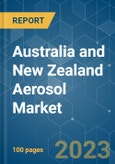Key Highlights
- The increasing demand for aerosol cans from the paint and coating industry and the increasing awareness related to hygiene and personal care are expected to drive the demand for aerosol cans.
- However, stringent regulations pertaining to the use of aerosol are expected to hinder the market's growth.
- The development of product innovations and increasing investments in the medical industry are likely to provide opportunities for growth in the coming years.
Australia And New Zealand Aerosol Market Trends
Increasing Awareness Regarding Hygiene and Personal Care
- Availability, cleanliness, and sustainability are three key factors consumers look for in beauty products. Both men and women want safe and effective products. Bag-on-valve aerosol cosmetics provide consistent and controlled spray results on sensitive areas, such as acne products for face and body fragrance.
- According to an article by Takea Tumble, Australia spends roughly USD 22 billion on beauty products every year. Women in Australia usually spend about USD 3,600 on the beauty industry every year. Out of the personal care sector, personal hygiene products are in the most demand.
- Currently, the revenue from the personal care segment in New Zealand is over USD 386.5 million. In the personal care segment, the number of users is expected to reach 1 million by 2025, supporting the consumption of aerosol cans in New Zealand.
- The increasing awareness about personal care has boosted the demand for cosmetics, such as deodorants, antiperspirants, cream foundations, hydrating creams, sun protection creams, tanning lotions, hair sprays, styling sprays, hair shines, and others, which is expected to further drive the market.
Australia Expected to Lead the Market
- Over 16 billion aerosols are produced worldwide each year, indicating their popularity, convenience, and cost-effectiveness. Every year, Australia purchases approximately 285 million aerosols, which equates to nearly 11.5 for every man, woman, and child.
- Aerosol is poised to witness major applications in the automotive aftermarket. The majority of enterprises in this sector are sole proprietorships or small businesses. Due to reasons such as technological progress, growing import costs, and capital expenditure connected with compliance requirements, the sector is becoming more competitive and complex. As a result of these changes, businesses have consolidated and rationalized, small and medium area repair techniques (SMART) have been used, and relationships with insurers have been formed.
- As per the Federal Chamber of Automotive Industries (FCAI), passenger vehicle sales in the country reached 16,245 units in 2023 from 14,941 units in 2022. Sales of light and heavy commercial vehicles increased by 31.18% and 1.06%, respectively, in 2023 compared to 2022, thus supporting the growth of the market studied.
- Furthermore, personal care and cosmetics are among the country's largest aerosol consumers. The growing consumption of skin care products, fragrance and body sprays, hair and styling sprays, shaving gels and foams, and other products have increased the demand for aerosols in the country.
- The construction sector is crucial to Australia's continued economic development. According to the Australian Bureau of Statistics, the total value of construction work done in Australia rose by 8.4% in the first half of 2023. This was due to a 16.0% YoY rise in civil engineering work and a 2.4% YoY rise in building work done during the period.
- In the healthcare industry, aerosol is used in inhalers and other spray medication applications. Australia's multibillion-dollar pharmaceutical business has been gradually rising over the last decade, and it appears to have maintained this growth despite the hurdles posed by the global coronavirus pandemic. Several of the country's 5.7 thousand pharmacies witnessed an increase in demand. Along with significant pharmaceutical merchants and distributors, Australia is also home to worldwide pharmaceutical and biotechnology firms such as CSL and Mayne Pharma.
- All the factors mentioned above are likely to boost the demand for the market studied across Australia in the coming years.
Australia And New Zealand Aerosol Industry Overview
The aerosol market in Australia and New Zealand is consolidated in nature. Major key players are (not in particular order) Unilever, Reckitt Benckiser Group PLC, Henkel AG & Co. KGaA, PPG Industries Inc., and Honeywell International Inc., among others.Additional Benefits:
- The market estimate (ME) sheet in Excel format
- 3 months of analyst support
This product will be delivered within 2 business days.
Table of Contents
Companies Mentioned (Partial List)
A selection of companies mentioned in this report includes, but is not limited to:
- Aerosolve
- Akzo Nobel NV
- BASF
- Colep Consumer Products
- Chemz Limited
- Damar
- MMP Industrial
- Henkel AG & Co. KGaA
- Liquid Engineering NZ
- Honeywell International Inc.
- PPG Industries Inc.
- Reckitt Benckiser Group PLC
- S.C. Johnson & Son Inc.
- The Sherwin-Williams Company
- Unilever








